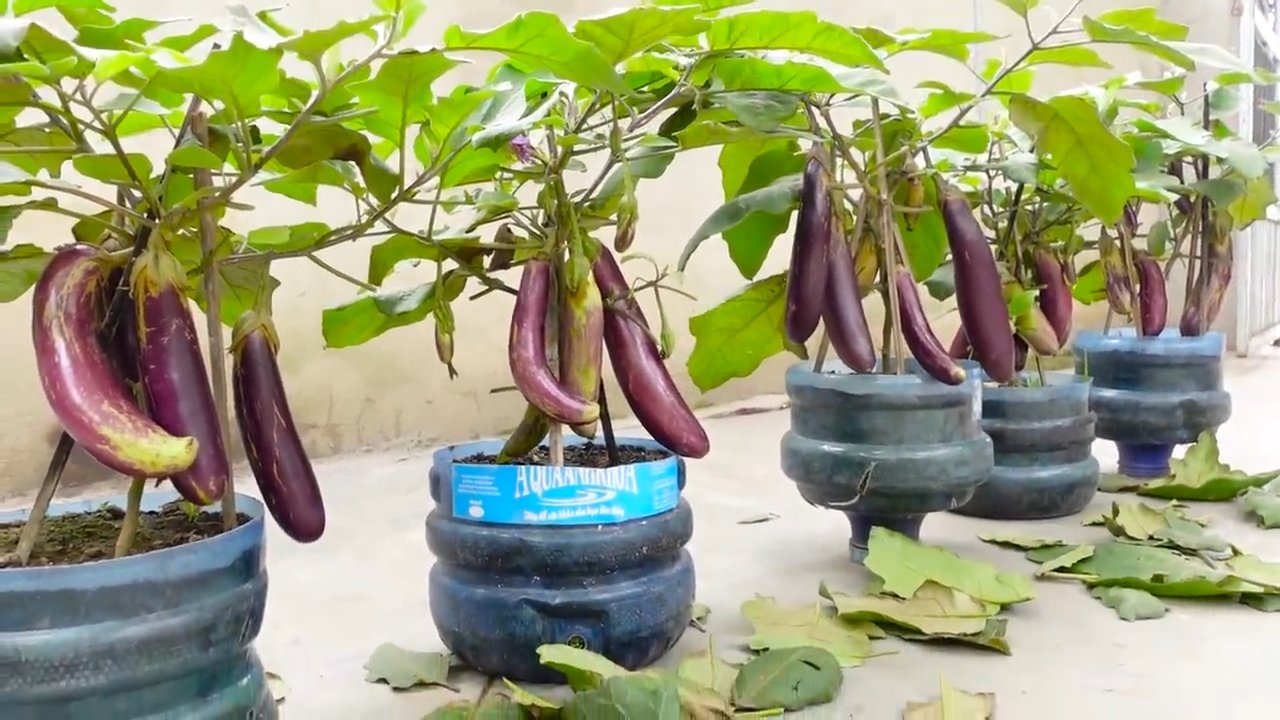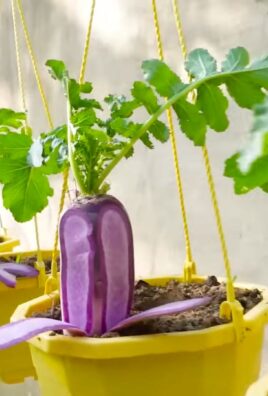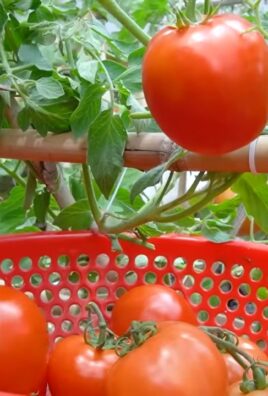Growing Fruitful Eggplants can feel like a daunting task, right? I get it! You envision plump, glossy eggplants gracing your garden, ready for delicious baba ghanoush or eggplant parmesan. But sometimes, reality falls short, leaving you with spindly plants and a disappointing harvest. Don’t worry, you’re not alone, and I’m here to help!
Eggplants have a rich history, cultivated for centuries in Asia and eventually making their way to the Mediterranean and beyond. They’ve been a staple in diverse cuisines, symbolizing prosperity and good health in some cultures. But regardless of their cultural significance, the joy of harvesting your own homegrown eggplants is universal.
That’s why I’ve put together this guide packed with DIY tricks and hacks to help you achieve eggplant success. We’ll dive into everything from soil preparation and companion planting to pest control and watering techniques. These aren’t just random tips; they’re tried-and-true methods that I’ve personally used to transform my eggplant patch from a struggle to a thriving, fruitful haven. Imagine the satisfaction of serving a meal featuring eggplants you nurtured from seed to table! So, let’s get started and unlock the secrets to growing fruitful eggplants that will make your garden the envy of the neighborhood!

DIY: So ziehst du üppige Auberginen – Mein Garten-Geheimnis!
Hey Gartenfreunde! Ich liebe Auberginen, und nichts ist befriedigender, als sie selbst anzubauen. Es ist gar nicht so schwer, wie man denkt, und mit ein paar Tricks und Kniffen kannst auch du eine reiche Ernte einfahren. Ich zeige dir, wie ich es mache, von der Aussaat bis zur Ernte!
Was du brauchst:
* Auberginensamen (Ich empfehle Sorten wie ‘Black Beauty’, ‘Violetta Lunga’ oder ‘Listada de Gandia’ für Anfänger)
* Anzuchterde
* Kleine Anzuchttöpfe oder eine Anzuchtschale
* Ein Mini-Gewächshaus oder Frischhaltefolie
* Pikierstab oder Bleistift
* Größere Töpfe (mindestens 10 Liter Volumen)
* Gemüseerde
* Tomatendünger (Auberginen sind Starkzehrer!)
* Pflanzstäbe oder Rankgitter (je nach Sorte)
* Gießkanne
* Gartenschere
* Mulchmaterial (z.B. Stroh oder Rasenschnitt)
Aussaat und Anzucht: Der Grundstein für eine reiche Ernte
Auberginen brauchen eine lange Wachstumsperiode, daher ist es wichtig, früh mit der Anzucht zu beginnen. Ich starte meistens Ende Februar oder Anfang März.
1. Vorbereitung der Anzuchttöpfe: Fülle die kleinen Anzuchttöpfe mit Anzuchterde. Drücke die Erde leicht an, aber nicht zu fest.
2. Aussaat der Samen: Lege in jeden Topf 2-3 Auberginensamen. Sie sollten etwa 0,5-1 cm tief in der Erde liegen.
3. Bedecken und Befeuchten: Bedecke die Samen mit einer dünnen Schicht Erde und befeuchte sie vorsichtig mit einer Sprühflasche. Die Erde sollte feucht, aber nicht nass sein.
4. Mini-Gewächshaus-Effekt: Stelle die Töpfe in ein Mini-Gewächshaus oder decke sie mit Frischhaltefolie ab. Das sorgt für eine hohe Luftfeuchtigkeit, die die Keimung fördert.
5. Warmer Standort: Stelle das Mini-Gewächshaus an einen warmen und hellen Ort. Auberginen lieben Wärme! Die ideale Keimtemperatur liegt bei 22-25°C.
6. Geduld ist gefragt: Nach etwa 1-2 Wochen sollten die ersten Keimlinge zu sehen sein. Lüfte das Mini-Gewächshaus regelmäßig, um Schimmelbildung zu vermeiden.
7. Ausdünnen: Sobald die Keimlinge ein paar Blätter haben, kannst du die schwächeren Pflanzen entfernen. Lasse nur die stärkste Pflanze pro Topf stehen.
Pikieren: Den kleinen Auberginen mehr Raum geben
Wenn die Auberginenpflänzchen groß genug sind (etwa 5-7 cm hoch), ist es Zeit zum Pikieren. Das bedeutet, dass du sie in größere Töpfe umpflanzt, damit sie mehr Platz zum Wachsen haben.
1. Vorbereitung der größeren Töpfe: Fülle die größeren Töpfe mit Gemüseerde.
2. Auberginen vorsichtig ausheben: Lockere die Erde in den Anzuchttöpfen vorsichtig auf. Hebe die Auberginenpflänzchen mit einem Pikierstab oder Bleistift vorsichtig aus den Töpfen. Achte darauf, die Wurzeln nicht zu beschädigen.
3. Einpflanzen: Setze die Auberginenpflänzchen in die größeren Töpfe. Die Wurzeln sollten gut mit Erde bedeckt sein.
4. Angießen: Gieße die Pflanzen nach dem Einpflanzen gut an.
5. Heller Standort: Stelle die pikierten Auberginen an einen hellen und warmen Ort.
Auspflanzen: Ab ins Freie!
Auberginen sind frostempfindlich, daher solltest du sie erst nach den Eisheiligen (Mitte Mai) ins Freie pflanzen.
1. Abhärten: Bevor du die Auberginen auspflanzt, solltest du sie langsam an die Bedingungen im Freien gewöhnen. Stelle sie tagsüber für ein paar Stunden nach draußen und hole sie abends wieder rein.
2. Vorbereitung des Beetes: Wähle einen sonnigen Standort für deine Auberginen. Der Boden sollte locker, humusreich und gut durchlässig sein. Bereite das Beet vor, indem du es auflockerst und mit Kompost anreicherst.
3. Pflanzabstand: Halte einen Pflanzabstand von etwa 50-60 cm zwischen den Pflanzen ein.
4. Einpflanzen: Hebe Pflanzlöcher aus, die groß genug sind, um die Wurzelballen der Auberginen aufzunehmen. Setze die Pflanzen in die Löcher und fülle sie mit Erde auf. Drücke die Erde leicht an.
5. Angießen: Gieße die Pflanzen nach dem Einpflanzen gut an.
6. Stütze geben: Je nach Sorte benötigen Auberginen eine Stütze, um nicht umzuknicken. Verwende Pflanzstäbe oder Rankgitter.
7. Mulchen: Bedecke den Boden um die Auberginen mit Mulchmaterial. Das hält den Boden feucht, unterdrückt Unkraut und schützt die Pflanzen vor Spritzwasser.
Pflege: Das A und O für gesunde Auberginen
Auberginen sind relativ pflegeleicht, aber ein paar Dinge solltest du beachten, um eine reiche Ernte zu erzielen.
1. Gießen: Auberginen brauchen regelmäßig Wasser, besonders während der Blütezeit und Fruchtbildung. Gieße am besten morgens, damit die Blätter bis zum Abend abtrocknen können. Vermeide Staunässe.
2. Düngen: Auberginen sind Starkzehrer und benötigen regelmäßig Dünger. Verwende am besten Tomatendünger, der speziell auf die Bedürfnisse von Fruchtgemüse abgestimmt ist. Dünge alle 2-3 Wochen.
3. Ausgeizen: Entferne regelmäßig die Seitentriebe, die in den Blattachseln wachsen. Das fördert die Bildung von Früchten und sorgt für eine bessere Belüftung der Pflanze.
4. Schädlinge und Krankheiten: Auberginen können von verschiedenen Schädlingen und Krankheiten befallen werden, wie z.B. Blattläusen, Spinnmilben oder Pilzkrankheiten. Kontrolliere deine Pflanzen regelmäßig und behandle sie bei Bedarf mit geeigneten Mitteln. Ich bevorzuge biologische Mittel.
5. Bestäubung: Auberginen sind Selbstbestäuber, aber die Bestäubung kann durch Wind oder Insekten gefördert werden. Du kannst die Blüten auch vorsichtig schütteln, um die Bestäubung zu unterstützen.
Ernte: Der Lohn der Mühe
Die Erntezeit für Auberginen ist meistens von Juli bis September.
1. Reife erkennen: Auberginen sind reif, wenn sie eine glänzende, pralle Haut haben und sich leicht eindrücken lassen. Die Farbe sollte intensiv sein.
2. Ernten: Schneide die Auberginen mit einer Gartenschere ab. Lasse einen kleinen Stiel an der Frucht.
3. Regelmäßig ernten: Ernte die Auberginen regelmäßig, um die Bildung neuer Früchte anzuregen.
Zusätzliche Tipps für eine erfolgreiche Auberginen-Ernte:
* Sortenwahl: Wähle Sorten, die für dein Klima geeignet sind. Informiere dich im Fachhandel oder im Internet.
* Fruchtfolge: Pflanze Auberginen nicht jedes Jahr am selben Standort. Wechsle die Kulturen, um Krankheiten und Schädlingen vorzubeugen.
* Begleitpflanzen: Pflanze Basilikum, Ringelblumen oder Tagetes neben deine Auberginen. Sie halten Schädlinge fern und fördern das Wachstum.
* Überwinterung: In milden Regionen kannst du Auberginen auch überwintern. Schneide die Pflanzen im Herbst zurück und stelle sie an einen hellen und kühlen Ort. Gieße sie nur sparsam.
Häufige Probleme und Lösungen:
* Blüten fallen ab: Das kann verschiedene Ursachen haben

Conclusion
So, there you have it – the secret to unlocking a bountiful eggplant harvest right in your own backyard! This simple, yet effective DIY trick for **growing fruitful eggplants** is more than just a gardening hack; it’s a game-changer. We’ve explored how a little proactive care can significantly impact the yield and quality of your eggplant crop, transforming your gardening experience from frustrating to fulfilling.
Why is this a must-try? Because it addresses a common problem faced by many gardeners: the struggle to get eggplants to produce abundantly. By implementing this technique, you’re not just passively waiting for nature to take its course; you’re actively intervening to create the optimal conditions for your plants to thrive. You’re essentially giving your eggplants a helping hand, ensuring they have the resources and support they need to develop into healthy, fruit-laden specimens.
But the beauty of this DIY trick lies not only in its effectiveness but also in its adaptability. Feel free to experiment with variations to suit your specific needs and preferences. For instance, if you live in a particularly windy area, you might consider using sturdier stakes or creating a more sheltered environment for your eggplants. Or, if you’re growing different varieties of eggplants, you can adjust the support system accordingly, taking into account the size and weight of the mature fruits.
Consider using different materials for your support system. Bamboo stakes are a classic choice, but you could also repurpose old tomato cages or even create your own custom supports using recycled materials. The key is to ensure that the support is strong enough to bear the weight of the developing eggplants and that it doesn’t damage the plants themselves.
Another variation to consider is the timing of the support installation. Some gardeners prefer to install the supports early on, when the plants are still young, while others wait until the plants start to produce fruit. There’s no right or wrong answer here; it’s simply a matter of personal preference and what works best for your particular growing conditions.
Ultimately, the goal is to create a supportive environment that allows your eggplants to reach their full potential. By providing them with the necessary support, you’re not only increasing your chances of a bountiful harvest but also reducing the risk of broken branches and damaged fruits.
We wholeheartedly encourage you to try this DIY trick for **growing fruitful eggplants** in your own garden. It’s a simple, cost-effective way to improve your eggplant yield and enjoy the satisfaction of harvesting your own homegrown produce. And once you’ve tried it, we’d love to hear about your experience! Share your photos, tips, and insights in the comments section below. Let’s learn from each other and create a community of successful eggplant growers! Your insights could be invaluable to other gardeners who are struggling to get their eggplants to produce. So, don’t be shy – share your story and help us all grow more fruitful eggplants!
Frequently Asked Questions (FAQ)
What type of support is best for eggplants?
The best type of support for eggplants depends on the variety you’re growing and your personal preferences. Bamboo stakes are a popular and affordable option, especially for smaller eggplant varieties. Tomato cages can also work well, providing a circular support system that helps to keep the plants upright. For larger, heavier eggplant varieties, you might consider using sturdier stakes or even building a custom support system using wood or metal. The key is to choose a support that is strong enough to bear the weight of the developing fruits and that won’t damage the plants.
When should I start supporting my eggplant plants?
The timing of support installation is a matter of personal preference. Some gardeners prefer to install the supports early on, when the plants are still young, while others wait until the plants start to produce fruit. Installing supports early can help to prevent the plants from flopping over as they grow, while waiting until the plants are fruiting allows you to better assess their needs and provide targeted support. Experiment to see what works best for you.
How do I attach the eggplant stems to the support?
Use soft plant ties, twine, or even strips of cloth to gently attach the eggplant stems to the support. Avoid using wire or anything that could cut into the stems. Make sure the ties are loose enough to allow for growth but tight enough to provide adequate support. Check the ties regularly and adjust them as needed as the plants grow.
Can I use this trick for other plants besides eggplants?
Yes, this DIY support trick can be adapted for use with other plants that tend to become top-heavy or require support, such as tomatoes, peppers, and even some flowering plants. The principles are the same: provide a sturdy support system that helps to keep the plants upright and prevents them from flopping over.
What if my eggplants are still not producing fruit after using this trick?
If your eggplants are still not producing fruit after using this support trick, there could be other factors at play. Make sure your plants are getting enough sunlight (at least 6-8 hours per day), water them regularly, and fertilize them with a balanced fertilizer. Also, check for pests and diseases and take appropriate action if necessary. Sometimes, eggplants simply need more time to mature and start producing fruit. Be patient and continue to provide them with the care they need.
How often should I water my eggplants?
Eggplants need consistent moisture to thrive. Water them deeply whenever the top inch of soil feels dry to the touch. Avoid overwatering, as this can lead to root rot. Mulching around the plants can help to retain moisture in the soil.
What kind of fertilizer should I use for eggplants?
Use a balanced fertilizer with equal amounts of nitrogen, phosphorus, and potassium (e.g., 10-10-10) or a fertilizer specifically formulated for vegetables. Fertilize your eggplants every 2-3 weeks during the growing season. Follow the instructions on the fertilizer package for application rates.
How do I protect my eggplants from pests and diseases?
Regularly inspect your eggplants for pests and diseases. Common pests include aphids, flea beetles, and spider mites. Common diseases include blossom-end rot and fungal infections. Use organic pest control methods, such as insecticidal soap or neem oil, to control pests. Ensure good air circulation around the plants to prevent fungal diseases.
Can I grow eggplants in containers?
Yes, you can grow eggplants in containers, but you’ll need to choose a large container (at least 5 gallons) and use a well-draining potting mix. Container-grown eggplants may require more frequent watering and fertilizing than those grown in the ground.
What are some good companion plants for eggplants?
Good companion plants for eggplants include basil, marigolds, and thyme. Basil helps to repel pests, while marigolds attract beneficial insects. Thyme can help to improve the flavor of the eggplants.




Leave a Comment